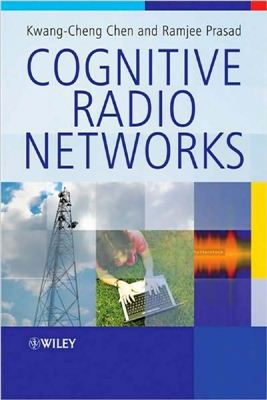John Wiley & Sons Ltd, 2009. – 362 pages.
Wireless communications and networks have experienced booming growth in the past few decades, with billions of new wireless devices in use each year. In the next decade we expect the exponential growth of wireless devices to result in a challenging shortage of spectrum suitable for wireless communications. Departing from the traditional approach to increase the spectral ef?ciency of physical layer transmission, Dr. Joe Mitola III’s innovative cognitive radio technology derived from software de?ned radio will enhance spectrum utilization by leveraging spectrum holes or white spaces. The Federal Communication Commission (FCC) in the US quickly identi?ed the potential of cognitive radio and endorsed the applications of such technology. During the past couples of years, there now exist more than a thousand research papers regarding cognitive radio technology in the IEEE Xplore database, which illustrates the importance of this technology. However, researchers have gradually come to realize that cognitive radio technology, at the link level, is not suf?cient to warrant the spectrum ef?ciency of wireless networks to transport packets, and networking these cognitive radios which coexist with primary/legacy radios through cooperative relay functions can further enhance spectrum utilization. Consequently, in light of this technology direction, we have developed this book on cognitive radio networks, to introduce state-of-the-art knowledge from cognitive radio to networking cognitive radios.
Wireless communications and networks have experienced booming growth in the past few decades, with billions of new wireless devices in use each year. In the next decade we expect the exponential growth of wireless devices to result in a challenging shortage of spectrum suitable for wireless communications. Departing from the traditional approach to increase the spectral ef?ciency of physical layer transmission, Dr. Joe Mitola III’s innovative cognitive radio technology derived from software de?ned radio will enhance spectrum utilization by leveraging spectrum holes or white spaces. The Federal Communication Commission (FCC) in the US quickly identi?ed the potential of cognitive radio and endorsed the applications of such technology. During the past couples of years, there now exist more than a thousand research papers regarding cognitive radio technology in the IEEE Xplore database, which illustrates the importance of this technology. However, researchers have gradually come to realize that cognitive radio technology, at the link level, is not suf?cient to warrant the spectrum ef?ciency of wireless networks to transport packets, and networking these cognitive radios which coexist with primary/legacy radios through cooperative relay functions can further enhance spectrum utilization. Consequently, in light of this technology direction, we have developed this book on cognitive radio networks, to introduce state-of-the-art knowledge from cognitive radio to networking cognitive radios.

